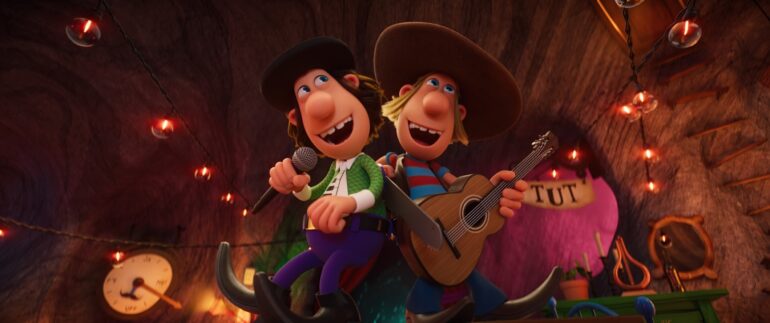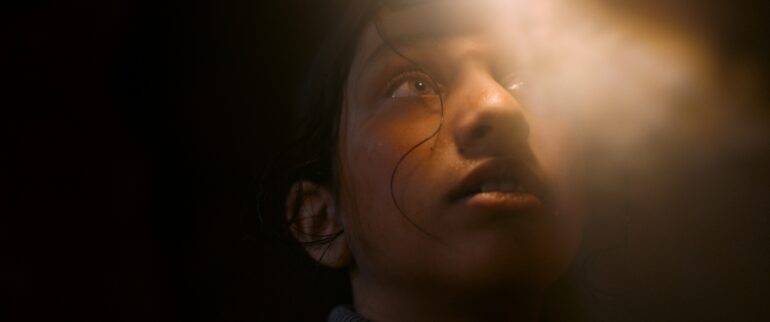
Solveig Langeland on the changing business of selling kids and animated films
Solveig Langeland on the changing business of selling kids and animated films
The head of Sola Media has a strong slate of Nordic films at the European Film Market including The Dragon Girl, Two Buddies & a Badger 2 and Dreambuilders.
Through her Stuttgart-based Sola Media, Langeland has been selling Nordic family and animation films for more than 15 years.
She has gradually moved into development, production and co-financing, taking executive production credits on films such as the Oscar eligible Danish animated film Dreambuilders, produced by Nynne Selin Eidnes for First Lady Film.
Sold to more than 70 territories, the film was one of Sola Media’s biggest successes of 2020, together with the Norwegian animated film Captain Sabertooth and the Magic Diamond, sold to more than 40 territories. Both films were backed by Nordisk Film & TV Fond.
The two titles are on Sola Media’s European Film Market (EFM)’s slate, together with the Norwegian family film Dragon Girl by Katarina Launing, and the animated film Two Buddies and a Badger-The Great Big Beast by Rune Spaans and Gunhild Enger.
Langeland spoke to us about her slate and the changing business of selling family and animated films.
Since 2004, your company has been specialising in kids content and animation. What is the share of Scandinavian titles in your catalogue and who are your regular providers?
Solveig Langeland: Scandinavian content accounts for approximately 55% of our catalogue and we work as executive producers on about 30% of the films, from development to delivery. We are working mostly with Norway and Denmark.
We have very successful relationships with Qvisten Animation, Fantefilm, Storm Film in Norway. In Denmark, we’ve worked with Crone Film, A Film and most recently with Nynne Selin Eidnes of First Lady Film. We’d love to do more in Sweden and in the rest of the Nordics.
What makes Scandinavian family and animated films stand out in the market?
SL: Scandinavians take kids seriously so they create quality content for kids, whereas producers in other markets sometimes think that kids won’t notice if the quality isn’t that high. Generally speaking, Scandinavian animation producers are very clever and get a lot out for their money. For a €3 million Scandinavian animated movie, you would get only 1/3 of a film in France and 1/2 a film in Germany. I would say that Scandinavia, Holland, Germany and France are the key territories producing quality content for families in Europe.
Heading your European Film Market catalogue are two new Nordic films: The Norwegian live/animated fantasy film Dragon Girl and animated film Two Buddies and a Badger: The Great Big Feast. What are their strong selling points?
SL: Fantasy films with a dragon are hugely popular and with Dragon Girl, the dragon is incredibly well made. At the same time, you have the topical theme of a young refugee girl on a run who tries to find her place in life. It’s fantasy meets real life, entertainment with depth.
Regarding Two Buddies and a Badger 2, it’s a beautifully animated film. One tricky thing is that it’s a musical film and it can be costly to dub the songs. We’ve now done it in English-language. We’re excited about it and we’re expecting international audiences to embrace it.
What have been your most successful Nordic family and animated films?
SL: Among animated films, the Captain Sabertooth franchise, Dreambuilders have been very popular, and in live action, Journey to the Christmas Star has done well internationally.
What sort of MGs do you offer?
SL: I won’t give details, but we do competitive MGs for animation. I don’t think we’re second to any competitor by any means in regards to what we’re offering. We’ve never really lost money on an animation film. Generally, what we pay upfront may be important for the financing of the film, but as soon as we start selling, we recoup our investment. So MGs aren’t always the best indication of the type of investment we make. That said, the best thing that we do is to pay producers’ overages.
You seem to use the traditional distribution model by selling individual rights to indie distributors in various territories…
SL: We try to find hybrid solutions, such as going theatrical in Europe, and with a streamer in other territories such as Latin America or Asian territories. We do believe in theatrical and this is still where you make the money. Streamers can perhaps give a nice chunk of money upfront, but if you have a great film, going the single territory route might be more lucrative at the other end. Hybrid releases will be there for a while and streamers have only been positive for us. They are also investing in a youth segment -teens and young adults- that has been more difficult for us to fill, both for theatrical and even free TV.
How have you navigated through the Covid-19 crisis?
SL: As we work mostly with animation, we actually had a very good 2020. All films were delivered on time, but releases worldwide were very fragmented. For instance with Dreambuilders, we had exceptional results in English speaking territories such as Australia and the UK due to the absence of competition from US studio movies, and the film was a good entertainment offer for families who could not travel.
In the UK the film released in July by Signature Entertainment stayed in the Top 10 for few weeks and broke £500K ($646,000) in B.O. revenues. In Australia the film released by Rialto has a BO of AUS$1.1 million which is incredible. Rialto spent quite a bit on P&A [prints and advertising] but they have already recouped from theatrical, so ancillary rights will probably be very solid as well.
In Germany Splendid Film did OK with the film (around 90,000 admissions), and in France, the film sold around 150,000 tickets via KMBO. We were expecting more, but the French market for animated films was very crowded in July after the lifting of the first lockdown so it ended up hurting the film’s release. In Spain and Italy results weren’t very strong.
As for the US, the film played one week in cinemas as part of the Oscars race. We are so proud that the film had qualified for the Oscars nominations. It’s a very special film, with a Pixar type of story that works both for kids and adults.
How has the global market for Scandinavian family and animated films changed in the last five years?
SL: For Scandinavian family films, scheduling is extremely important. Having 1-2 weekends or holiday time without too much competition is crucial. But in the past few years, it’s been very hard to secure a spot as US studios have increased their animation content.
However, Covid-19 has changed US Studios’ release strategies and they are clearly looking for new distribution models. Disney+ has already 95 million global subscribers and Netflix has used the pandemic to ramp up its kids content with product from Sony or Paramount. We hope that US studios’ move to DTC [direct to consumers] will free some space for independent distributors.
On a production perspective, the growing success of animation means that more independent companies are active in the sector, so we’ve seen more competition coming from Russia, Ukraine, Spain, as well as China where films might not be so strong story-wise, but clearly on a technical standpoint.
How have you adapted to the changes on the market?
SL: We are working earlier on the films, reading scripts, trying to make changes we feel are important. We’ve been working as executive producers for a while, without always having the credit. As we are clearly competing against the majors, we have to make sure that stories are at their best. You need to have engaging characters, and a plot that’s fun for both kids and adults. I always say: make me care!
As animation takes six-seven years from idea to delivery, you need to have a vision and a strategy to make the original idea work across different formats and platforms. If your vision stops at a standalone movie, then no one will buy the game, the pyjama or any merchandise; you won’t even get shelf space.
At Sola Media, our goal is to have more animated films and to give our collaborators a 360° service.
Is it to support your growth strategy that you’ve sold your shares to Koch Films, part of the Austrian group Koch Media last summer?
SL: Yes in today’s changing market, you need to be stronger and you need reliable partners. Koch Films supports not only our back office and acquisitions, but will help us expand across new markets, such as gaming where Koch Media is very active.
As a sales company, you can’t only rely on a poster, a trailer and a film. You need to reinvent yourself, to find the audience where they are. We use marketing in a more aggressive way, to create communities on social media.
Today, in the digital world, you might have lost revenues from DVD, free TV, but you’ve also cut costs on buying advertising space such as billboard campaigns and TV spots that you had to do to have a reach. Now, if you’re smart, you can create campaigns for much less with short clips and make them viral on Youtube, Instagram etc. I always tell the producers: ‘if you’re going to make a film, then story, story story, and marketing is what you have to focus on’.
Where would you like to be in three years?
SL: I don’t think we’ll do things exactly like today. We’ll continue to give our input as early as possible to producers and we’ll go stronger into social media to see how to build communities. I believe our role will continue to evolve into development, co-financing and marketing.

